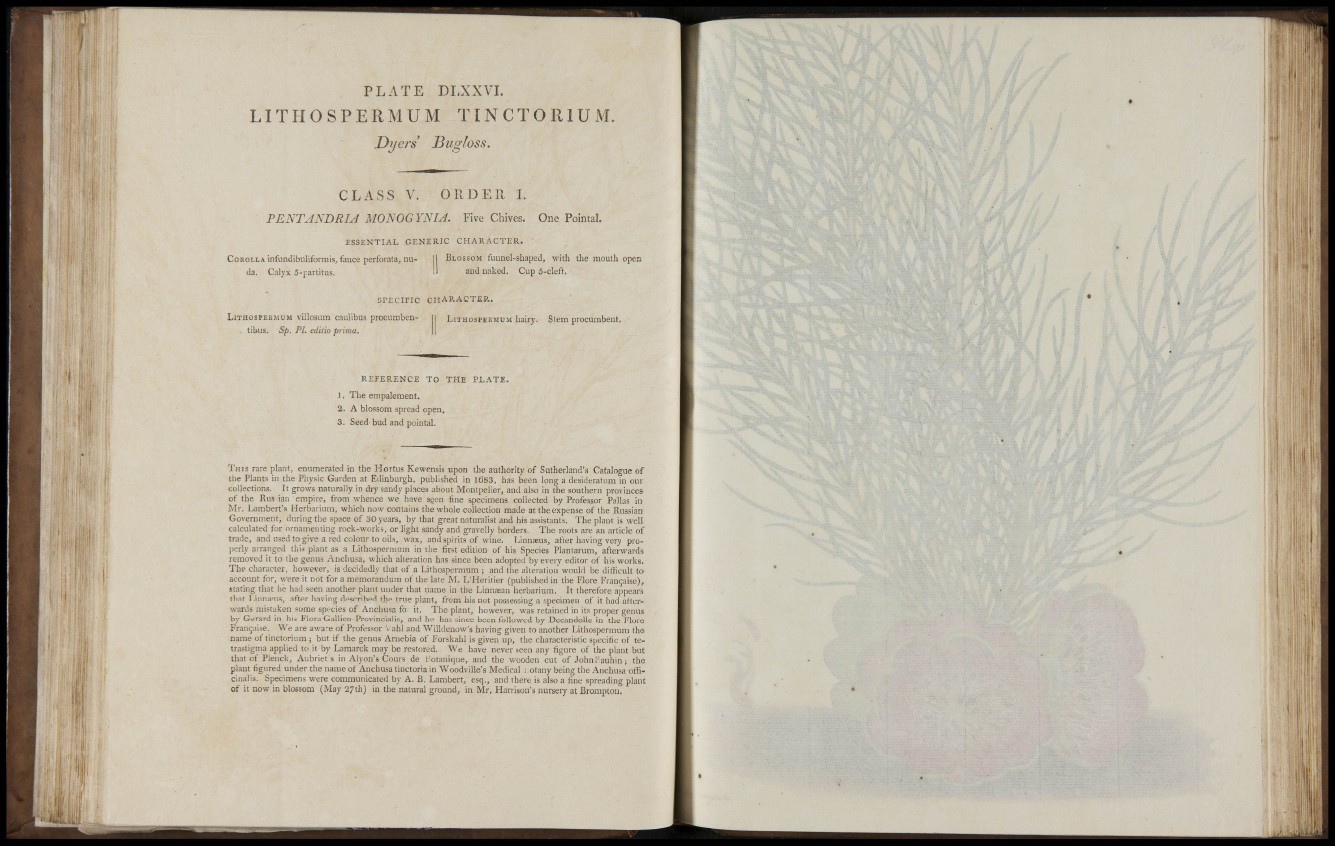
PLATE DI.XXVL
L I T H O S P E R M U M T I N C T O R 1 U M.
D}jers Bu gloss.
CLASS A^ ORDER I.
PENTJNDRIA MONOGYNIA. Five Chives. One Pointal.
ESSENTIAL GENERIC CHARACTER.
COROLLA infundibuliformis^ fauce perforata^ nuda.
Calyx 5-partitus.
BLOSSOM funnel-shaped, with the mouth opea
and naked. Cup 5-cleft.
LITHOSPEEÎIUM villosum caalibus procumben-
- tibus. Sp. PI. edilio prima.
SPECIFIC CHARACTER.
LITHOSPEEMUM hairy. Stem procumbent.
h
REFERENCE TO THE PLATE.
] . The empalement.
2. A blossom spread open,.
3. Seed-bud and pointal.
THIS rare plant, enumerated in the Hortus Kewensis upon the authority of Sutherland's Catalogue of
the Plants in the Physic Garden at Eilinburgh, published in l6S3, has been long a desideratum in our
collections. It grows naturally in dry sandy places about Monlpelier, and also in the southern provinces
of the Rus ian empire, from whence we have sgen fine specimens collected by Professor Pallas in
Mr. Lambert's Herbarium, which no'.v contains the whole collection made at the expense of the Russian
Government, during the space of 30 years, by that great naturalist and his assistants. The plant is well
calculated for ornamenting rock-works, or light sandy and gravelly borders. The roots are an article of
trade, and used to give a red colour to oils, wax, and spirits of wine. T.innaeus, after having very properly
arranged this plant as a Lithospermum in the first edition of his Species Plantarum, afterwards
removed it to the genus Anchusa, which alteration has since been adopted by every editor of his works.
The character, however, is decidedly that of a Lithospermum ; and the alteration' would be difficult to
account for, were it not for a memorandum of the late M. L'Herifier (published in the Flore Française),
stating that he had seen another plant under that name in the Linnaean herbarium. It therefore appears
that Linnoeus, after having described the true plant, from his not possessing a specimen of it had afterwards
mistaken some species of Anchusa fo it. The plant, however, was retained in its proper genus
by Gerard in his Flora Gallico-Provincialis, and he has since been followed by Decandolle in the Flore
Française. We are awave of Professor V ahl and Willdenow' s having given to another Lithospermum the
name of tinctorium ; but if the genus Arnebia of Forskahl is given up, the characteristic specific of tetrastignia
applied to it by Lamarck may be restored. We have never seen any figure of the plant but
that of Pienck, Aubriet s in Alyon's Cours de botanique, and the wooden cut of Johnl'auhin; the
plant figured under the name ot Anchusa tiiictoria in Woodville's Medical i otany being the Anchusa officinalis.
Specimens were communicated by A. B. Lambert, esq., and there is also a fine spreading plant
of it now in blossom (May 27th) in the natural ground, in Mr. Harrison's nursery at Bromptou.
. f i l i •!